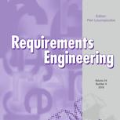Weak alignment of requirements engineering (RE) with verification and validation (VV) may lead to problems in delivering the required products in time with the right quality. For example, weak communication of requirements changes to testers may result in lack of verification of new requirements and incorrect verification of old invalid requirements, leading to software quality problems, wasted effort and delays. However, despite the serious implications of weak alignment research and practice both tend to focus on one or the other of RE or VV rather than on the alignment of the two. We have performed a multi-unit case study to gain insight into issues around aligning RE and VV by interviewing 30 practitioners from 6 software developing companies, involving 10 researchers in a flexible research process for case studies. The results describe current industry challenges and practices in aligning RE with VV, ranging from quality of the individual RE and VV activities, through tracing and tools, to change control and sharing a common understanding at strategy, goal and design level. The study identified that human aspects are central, i.e. cooperation and communication, and that requirements engineering practices are a critical basis for alignment. Further, the size of an organisation and its motivation for applying alignment practices, e.g. external enforcement of traceability, are variation factors that play a key role in achieving alignment. Our results provide a strategic roadmap for practitioners improvement work to address alignment challenges. Furthermore, the study provides a foundation for continued research to improve the alignment of RE with VV.
相關內容
Most of the existing work in one-stage referring expression comprehension (REC) mainly focuses on multi-modal fusion and reasoning, while the influence of other factors in this task lacks in-depth exploration. To fill this gap, we conduct an empirical study in this paper. Concretely, we first build a very simple REC network called SimREC, and ablate 42 candidate designs/settings, which covers the entire process of one-stage REC from network design to model training. Afterwards, we conduct over 100 experimental trials on three benchmark datasets of REC. The extensive experimental results not only show the key factors that affect REC performance in addition to multi-modal fusion, e.g., multi-scale features and data augmentation, but also yield some findings that run counter to conventional understanding. For example, as a vision and language (V&L) task, REC does is less impacted by language prior. In addition, with a proper combination of these findings, we can improve the performance of SimREC by a large margin, e.g., +27.12% on RefCOCO+, which outperforms all existing REC methods. But the most encouraging finding is that with much less training overhead and parameters, SimREC can still achieve better performance than a set of large-scale pre-trained models, e.g., UNITER and VILLA, portraying the special role of REC in existing V&L research.
Conversational recommender systems (CRS) generate recommendations through an interactive process. However, not all CRS approaches use human conversations as their source of interaction data; the majority of prior CRS work simulates interactions by exchanging entity-level information. As a result, claims of prior CRS work do not generalise to real-world settings where conversations take unexpected turns, or where conversational and intent understanding is not perfect. To tackle this challenge, the research community has started to examine holistic CRS, which are trained using conversational data collected from real-world scenarios. Despite their emergence, such holistic approaches are under-explored. We present a comprehensive survey of holistic CRS methods by summarizing the literature in a structured manner. Our survey recognises holistic CRS approaches as having three components: 1) a backbone language model, the optional use of 2) external knowledge, and/or 3) external guidance. We also give a detailed analysis of CRS datasets and evaluation methods in real application scenarios. We offer our insight as to the current challenges of holistic CRS and possible future trends.
The enhancement of unsupervised learning of sentence representations has been significantly achieved by the utility of contrastive learning. This approach clusters the augmented positive instance with the anchor instance to create a desired embedding space. However, relying solely on the contrastive objective can result in sub-optimal outcomes due to its inability to differentiate subtle semantic variations between positive pairs. Specifically, common data augmentation techniques frequently introduce semantic distortion, leading to a semantic margin between the positive pair. While the InfoNCE loss function overlooks the semantic margin and prioritizes similarity maximization between positive pairs during training, leading to the insensitive semantic comprehension ability of the trained model. In this paper, we introduce a novel Identical and Fraternal Twins of Contrastive Learning (named IFTCL) framework, capable of simultaneously adapting to various positive pairs generated by different augmentation techniques. We propose a \textit{Twins Loss} to preserve the innate margin during training and promote the potential of data enhancement in order to overcome the sub-optimal issue. We also present proof-of-concept experiments combined with the contrastive objective to prove the validity of the proposed Twins Loss. Furthermore, we propose a hippocampus queue mechanism to restore and reuse the negative instances without additional calculation, which further enhances the efficiency and performance of the IFCL. We verify the IFCL framework on nine semantic textual similarity tasks with both English and Chinese datasets, and the experimental results show that IFCL outperforms state-of-the-art methods.
Identifiability of discrete statistical models with latent variables is known to be challenging to study, yet crucial to a model's interpretability and reliability. This work presents a general algebraic technique to investigate identifiability of complicated discrete models with latent and graphical components. Specifically, motivated by diagnostic tests collecting multivariate categorical data, we focus on discrete models with multiple binary latent variables. In the considered model, the latent variables can have arbitrary dependencies among themselves while the latent-to-observed measurement graph takes a "star-forest" shape. We establish necessary and sufficient graphical criteria for identifiability, and reveal an interesting and perhaps surprising phenomenon of blessing-of-dependence geometry: under the minimal conditions for generic identifiability, the parameters are identifiable if and only if the latent variables are not statistically independent. Thanks to this theory, we can perform formal hypothesis tests of identifiability in the boundary case by testing certain marginal independence of the observed variables. Our results give new understanding of statistical properties of graphical models with latent variables. They also entail useful implications for designing diagnostic tests or surveys that measure binary latent traits.
In a microservices-based system, reliability and availability are key components to guarantee the best-in-class experience for the consumers. One of the key advantages of microservices architecture is the ability to independently deploy services, providing maximum change flexibility. However, this introduces an extra complexity in managing the risk associated with every change: any mutation of a service might cause the whole system to fail. In this research, we would propose an algorithm to enable development teams to determine the risk associated with each change to any of the microservices in the system.
Comparing different age estimation methods poses a challenge due to the unreliability of published results stemming from inconsistencies in the benchmarking process. Previous studies have reported continuous performance improvements over the past decade using specialized methods; however, our findings challenge these claims. This paper identifies two trivial, yet persistent issues with the currently used evaluation protocol and describes how to resolve them. We describe our evaluation protocol in detail and provide specific examples of how the protocol should be used. We utilize the protocol to offer an extensive comparative analysis for state-of-the-art facial age estimation methods. Surprisingly, we find that the performance differences between the methods are negligible compared to the effect of other factors, such as facial alignment, facial coverage, image resolution, model architecture, or the amount of data used for pretraining. We use the gained insights to propose using FaRL as the backbone model and demonstrate its efficiency. The results emphasize the importance of consistent data preprocessing practices for reliable and meaningful comparisons. We make our source code public at //github.com/paplhjak/Facial-Age-Estimation-Benchmark.
Automatic static cost analysis infers information about the resources used by programs without actually running them with concrete data, and presents such information as functions of input data sizes. Most of the analysis tools for logic programs (and other languages) are based on setting up recurrence relations representing (bounds on) the computational cost of predicates, and solving them to find closed-form functions that are equivalent to (or a bound on) them. Such recurrence solving is a bottleneck in current tools: many of the recurrences that arise during the analysis cannot be solved with current solvers, such as Computer Algebra Systems (CASs), so that specific methods for different classes of recurrences need to be developed. We address such a challenge by developing a novel, general approach for solving arbitrary, constrained recurrence relations, that uses machine-learning sparse regression techniques to guess a candidate closed-form function, and a combination of an SMT-solver and a CAS to check whether such function is actually a solution of the recurrence. We have implemented a prototype and evaluated it with recurrences generated by a cost analysis system (the one in CiaoPP). The experimental results are quite promising, showing that our approach can find closed-form solutions, in a reasonable time, for classes of recurrences that cannot be solved by such a system, nor by current CASs.
Face recognition technology has advanced significantly in recent years due largely to the availability of large and increasingly complex training datasets for use in deep learning models. These datasets, however, typically comprise images scraped from news sites or social media platforms and, therefore, have limited utility in more advanced security, forensics, and military applications. These applications require lower resolution, longer ranges, and elevated viewpoints. To meet these critical needs, we collected and curated the first and second subsets of a large multi-modal biometric dataset designed for use in the research and development (R&D) of biometric recognition technologies under extremely challenging conditions. Thus far, the dataset includes more than 350,000 still images and over 1,300 hours of video footage of approximately 1,000 subjects. To collect this data, we used Nikon DSLR cameras, a variety of commercial surveillance cameras, specialized long-rage R&D cameras, and Group 1 and Group 2 UAV platforms. The goal is to support the development of algorithms capable of accurately recognizing people at ranges up to 1,000 m and from high angles of elevation. These advances will include improvements to the state of the art in face recognition and will support new research in the area of whole-body recognition using methods based on gait and anthropometry. This paper describes methods used to collect and curate the dataset, and the dataset's characteristics at the current stage.
This work considers the question of how convenient access to copious data impacts our ability to learn causal effects and relations. In what ways is learning causality in the era of big data different from -- or the same as -- the traditional one? To answer this question, this survey provides a comprehensive and structured review of both traditional and frontier methods in learning causality and relations along with the connections between causality and machine learning. This work points out on a case-by-case basis how big data facilitates, complicates, or motivates each approach.
The notion of uncertainty is of major importance in machine learning and constitutes a key element of machine learning methodology. In line with the statistical tradition, uncertainty has long been perceived as almost synonymous with standard probability and probabilistic predictions. Yet, due to the steadily increasing relevance of machine learning for practical applications and related issues such as safety requirements, new problems and challenges have recently been identified by machine learning scholars, and these problems may call for new methodological developments. In particular, this includes the importance of distinguishing between (at least) two different types of uncertainty, often refereed to as aleatoric and epistemic. In this paper, we provide an introduction to the topic of uncertainty in machine learning as well as an overview of hitherto attempts at handling uncertainty in general and formalizing this distinction in particular.




